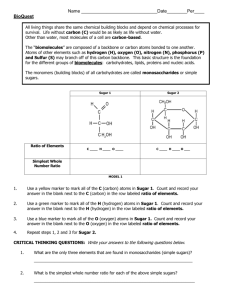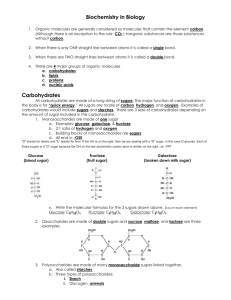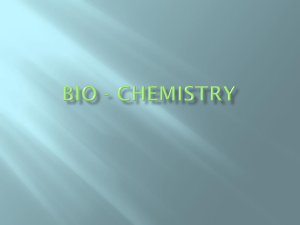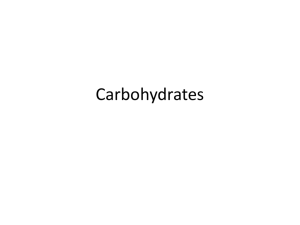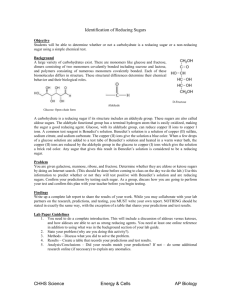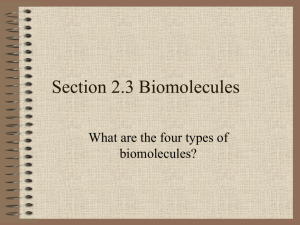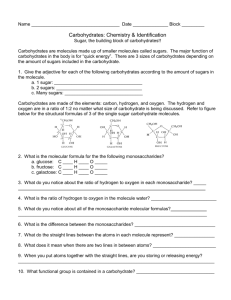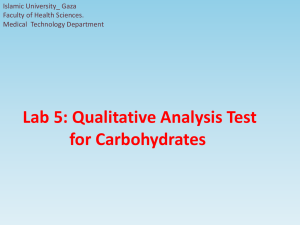Lab 5: Qualitative Analysis Test for Carbohydrates
advertisement
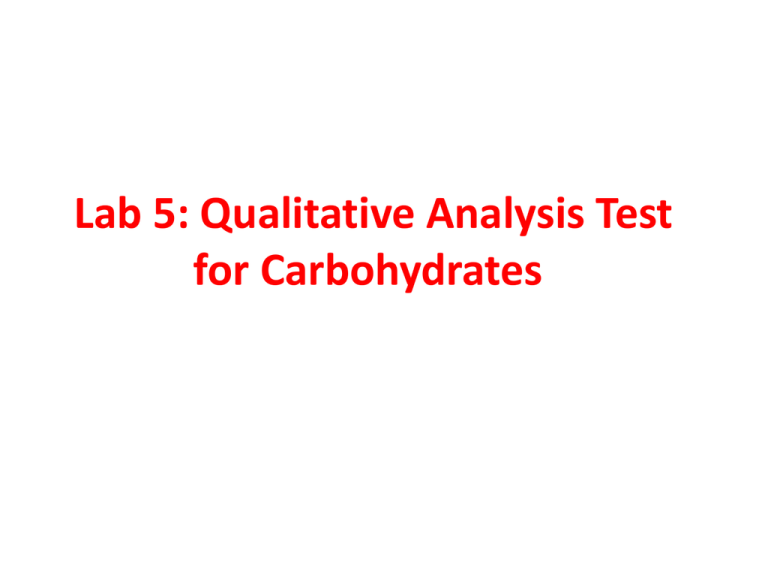
Lab 5: Qualitative Analysis Test for Carbohydrates Qualitative Analysis Test • Is concerned with determining, the identity of a substance. • Enables us to detect the presence of things which may be beyond the reach of our senses. Simple and complex carbohydrates • Simple are found in foods such as fruits, milk, and vegetables and provide energy but lack vitamins, minerals, and fibers. • Needs short time for digestion. • Complex are provide energy, vitamins, minerals and fibers such as rice and starchy vegetables' • Need longer time to digest Types of Carbohydrates • Most naturally occurring sugars are D isomers. • Monosaccharides are the simplest carbohydrates - Also called “simple sugars”, cannot be hydrolyzed to simpler carbohydrates - Examples: glucose, fructose, galactose, ribose • Disaccharides are two monosaccharides bonded together. - Examples: sucrose (table sugar), lactose (milk sugar). • Oligosaccharides - a few monosaccharides covalently linked. • Polysaccharides are polymers of monosaccharides - Can be split into many monosaccharides with acid or enzymes - Examples: starch, cellulose, glycogen • The joining of two hexoses by the glycosidic bond causes the formation of disaccharide. • Longer chains composed of 3-10 monosaccharide units are called oligosaccharides. • Polysaccharides usually contain hundreds or thousands of monosaccharide units. Sugar Nomenclature For sugars with more than one chiral center, D or L refers to the asymmetric C farthest from the aldehyde or keto group. Most naturally occurring sugars are D isomers. O H C H – C – OH HO – C – H H – C – OH H – C – OH CH2OH D-glucose O H C HO – C – H H – C – OH HO – C – H HO – C – H CH2OH L-glucose Cyclization of glucose produces a new asymmetric center at C1. The 2 stereoisomers are called anomers, a & b. Haworth projections represent the cyclic sugars as having essentially planar rings, with the OH at the anomeric C1: a (OH below the ring) b (OH above the ring). 6 CH2OH 6 CH2OH 5 H 4 OH O H OH 3 H H 2 OH a-D-glucose H 1 OH H 4 OH 5 O OH H OH H 1 3 H 2 OH b-D-glucose H The active part in sugars is aldehyde or ketone group. The presence of aldehyde or ketone groups and hydroxyl groups causes that the sugars have typical reactions for aldehydes/ketones and alcohols. Opend and closed form of monosaccarides Classification upon reducing end 1. Reducing Sugars • • • • Oxidation: loss of electrons Reduction: gain of electrons Have aldehyde group Sugars that can be oxidized by mild oxidizing agents and the oxidizing agent is reduced in the reaction. ( Can be oxidized to acid,Reduces another compound) • All monosaccharides • Maltose, Lactose • A reducing sugar is a carbohydrate possessing either a free aldehyde or free ketone functional group as part of its molecular structure. A functional groups are the regions of a molecule that gives it particular properties. A single molecule can have more than one functional group as part of its structure. • All of the monosaccharides and most of the disaccharides can be oxidized. • Sugars exist in solution as an equilibrium mixture of open-chain and closed-ring (or cyclic) structures. • All monosaccharides have an open and closed form structure, but oligosaccharides have only closed structure. • When the cyclic structure opens, the aldehyde group is available for oxidation. Lactose is a reducing sugar, why? • ( one of the carbonyle groups are free) • a carbonyl group is a functional group composed of a carbon atom double-bonded to an oxygen atom: C=O. 2. NON Reducing Sugars • is not oxidized by mild oxidizing agents. • Sucrose • All polysaccharides Sucrose is not a reducing sugar, why? • Sucrose is not a reducing sugar because it cannot revert to the open-chain form that would provide the aldehyde group needed to reduce the cupric ion. (the carbonyle groups are busy in the to side) • • Common oxidizing agents used to test for the presence of a reducing sugar are: Benedict's solution, Fehling's solution and picric acid solution. • An oxidizing agent (also called an oxidizer or oxidant) is referred to as a chemical compound that readily transfers oxygen atoms or a substance that gains electrons in a redox chemical reaction. • Aldose(glucose) ---- oxidation ----- carboxylate • Ketose(fructose) ----- oxidation----- hydroxyl carboxylate Oxidizing Reagent Benedict's Solution Fehling's Solution Tollen's Reagent copper sulfate in copper sulfate in alkaline silver nitrate in aqueous alkaline citrate tartrate ammonia Color of Solution deep blue deep blue colorless Color After Reaction with a brick red precipitate brick red precipitate silver mirror forms Reducing Sugar Cu2O(s) Cu2O(s) Ag(s) Species Being Reduced Cu2+ Cu2+ Ag+ (the oxidant) Cu2+ + e ---> Cu+ Cu2+ + e ---> Cu+ Ag+ + e ---> Ag(s) Species Being Oxidized reducing sugar reducing sugar reducing sugar (the reductant) oxidized to carboxylate oxidized to carboxylate oxidized to carboxylate Composition
